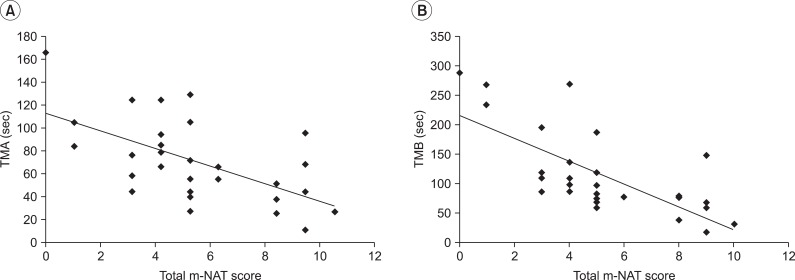Ann Rehabil Med.
2013 Feb;37(1):57-65. 10.5535/arm.2013.37.1.57.
Development of a Modified Naturalistic Action Test for Korean Patients With Impaired Cognition
- Affiliations
-
- 1Department of Rehabilitation Medicine, Eulji General Hospital, Eulji University School of Medicine, Seoul, Korea. khj2603@eulji.ac.kr
- KMID: 2266651
- DOI: http://doi.org/10.5535/arm.2013.37.1.57
Abstract
OBJECTIVE
To develop and evaluate the psychometric properties of a modified Naturalistic Action Test (m-NAT) for Korean patients with impaired cognition. The NAT was originally designed to assess everyday action impairment associated with higher cortical dysfunction.
METHODS
We developed the m-NAT by adapting the NAT for the Korean cultural background. The m-NAT was modeled as closely as possible on the original version in terms of rules and scoring. Thirty patients receiving neurorehabilitation (twenty-three stroke patients, five traumatic brain injury patients, and two dementia patients) and twenty healthy matched controls were included. Inter-rater reliability was assessed between two raters. Validity was evaluated by comparing the m-NAT score with various measures of attention, executive functions, and daily life.
RESULTS
Performance on the m-NAT in terms of the total score was significantly different between patients and controls (p<0.01). Patients made significantly more total errors than controls (p<0.01). Omissions error was the most frequent type of error in patient group. Intraclass correlation coefficients for total m-NAT score was 0.95 (95% confidence interval [CI], 0.92 to 0.97; p<0.001); total error was 0.91 (95% CI, 0.89 to 0.92; p<0.001). Total m-NAT score showed moderate to strong correlations with Stroop test interference score & index, Trail Making Test parts A and B, Sustained Attention to Response Task commission error, Functional Independence Measure, Korean instrumental activities of daily living, Korean version of the Cognitive Failures Questionnaire, and Executive Behavior Scale (p<0.05).
CONCLUSION
The m-NAT showed very good inter-rater reliability and adequate validity. The m-NAT adjusted to Korean cultural background can be useful in performance-based assessment of naturalistic action for clinical and research purposes.
Keyword
MeSH Terms
Figure
Reference
-
1. Anderson CV, Bigler ED, Blatter DD. Frontal lobe lesions, diffuse damage, and neuropsychological functioning in traumatic brain-injured patients. J Clin Exp Neuropsychol. 1995; 17:900–908. PMID: 8847395.
Article2. Stuss DT, Benson DF. Neuropsychological studies of the frontal lobes. Psychol Bull. 1984; 95:3–28. PMID: 6544432.
Article3. Malloy P, Bihrle A, Duffy J, Cimino C. The orbitomedial frontal syndrome. Arch Clin Neuropsychol. 1993; 8:185–201. PMID: 14589631.
Article4. Goldberg E, Bougakov D. Neuropsychologic assessment of frontal lobe dysfunction. Psychiatr Clin North Am. 2005; 28:567–580. PMID: 16122567.
Article5. Fortin S, Godbout L, Braun CM. Cognitive structure of executive deficits in frontally lesioned head trauma patients performing activities of daily living. Cortex. 2003; 39:273–291. PMID: 12784889.
Article6. Stuss DT, Levine B. Adult clinical neuropsychology: lessons from studies of the frontal lobes. Annu Rev Psychol. 2002; 53:401–433. PMID: 11752491.
Article7. Burgess PW, Alderman N, Forbes C, Costello A, Coates LM, Dawson DR, et al. The case for the development and use of "ecologically valid" measures of executive function in experimental and clinical neuropsychology. J Int Neuropsychol Soc. 2006; 12:194–209. PMID: 16573854.
Article8. Chan RC, Shum D, Toulopoulou T, Chen EY. Assessment of executive functions: review of instruments and identification of critical issues. Arch Clin Neuropsychol. 2008; 23:201–216. PMID: 18096360.
Article9. Manchester D, Priestley N, Jackson H. The assessment of executive functions: coming out of the office. Brain Inj. 2004; 18:1067–1081. PMID: 15545205.
Article10. Shallice T, Burgess PW. Deficits in strategy application following frontal lobe damage in man. Brain. 1991; 114(Pt 2):727–741. PMID: 2043945.
Article11. Knight C, Alderman N, Burgess PW. Development of a simplified version of the Multiple Errands Test for use in hospital settings. Neuropsychol Rehabil. 2002; 12:231–255.
Article12. Dawson DR, Anderson ND, Burgess P, Cooper E, Krpan KM, Stuss DT. Further development of the Multiple Errands Test: standardized scoring, reliability, and ecological validity for the Baycrest version. Arch Phys Med Rehabil. 2009; 90(11 Suppl):S41–S51. PMID: 19892074.
Article13. Schwartz MF, Montgomery MW, Buxbaum LJ, Lee SS, Carew TG, Coslett HB, et al. Naturalistic action impairment in closed head injury. Neuropsychology. 1998; 12:13–28. PMID: 9460731.
Article14. Schwartz MF, Segal M, Veramonti T, Ferraro M, Buxbaum LJ. The Naturalistic Action Test: a standardised assessment for everyday action impairment. Neuropsychol Rehabil. 2002; 12:311–339.
Article15. Kim HK. Kims Frontal-Executive Neuropsychological Test. 2001. Daegu, Korea: Neuropsychology Press.16. Robertson IH, Manly T, Andrade J, Baddeley BT, Yiend J. 'Oops!': performance correlates of everyday attentional failures in traumatic brain injured and normal subjects. Neuropsychologia. 1997; 35:747–758. PMID: 9204482.
Article17. Uniform Data System for Medical Rehabilitation. Guide for use of the uniform data set for medical rehabilitation (adult FIM), version 4.0. 1993. Buffalo: State University of New York at Buffalo.18. Kang SJ, Choi SH, Lee BH, Kwon JC, Na DL, Han S, et al. The reliability and validity of the Korean instrumental activities of daily living (K-IADL). J Korean Neurol Assoc. 2002; 20:8–14.19. Kim HJ, Kang YJ, Park HK. Cross-cultural adaptation and development of Korean version of Cognitive Failure Questionnaire. Annu Bull Bum-Suk Acad Scholarship Found. 2011; 14:77–88.20. Shallice T, Burgess P. Levin HS, Eisenberg HM, Benton AL, editors. Higher-order cognitive impairments and frontal lobe lesions. Frontal lobe function and dysfunction. 1991. New York: Oxford University Press;p. 125–138.21. Norman DA, Shallice T. Gazzaniga MS, editor. Attention to action: willed and automatic control of behavior. Cognitive neuroscience: a reader. 2000. Malden, MA: Blackwell;p. 376–390.22. Deneman M, Carpenter PA. Individual differences in working memory and reading. J Verbal Learning Verbal Behav. 1980; 19:450–466.
- Full Text Links
- Actions
-
Cited
- CITED
-
- Close
- Share
- Similar articles
-
- Utilization and Application of Modified Action Camera in Otorhinolaryngoloic Surgery
- The Relationship of Clinical Symptoms with Social Cognition in Children Diagnosed with Attention Deficit Hyperactivity Disorder, Specific Learning Disorder or Autism Spectrum Disorder
- Development of the Korean Version of the Pain Assessment Tool in Impaired Cognition (KPAIC-15) for Patients with Dementia: A Scale Development
- Characteristics of Cognitive Dysfunction in Intracerebral Hemorrhagic Patients with Basal Ganglia and Thalamic Lesion
- Development of New Drug for Cognitive Enhancement of Schizophrenia: Introduction of Measurement And Treatment Research to Improve Cognition in Schizophrenia(MATRICS)



